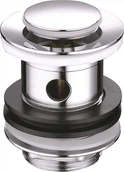Hey there! I'm a supplier of sink waste, and I've seen firsthand how the stuff that goes down our sinks can mess with the pH level of wastewater. It's a topic that doesn't get as much attention as it should, but it's super important for keeping our environment clean and our plumbing systems in good shape. So, let's dive into how sink waste affects the pH level of wastewater.
First off, what's pH? It's a measure of how acidic or basic a substance is, on a scale from 0 to 14. A pH of 7 is neutral, below 7 is acidic, and above 7 is basic. The ideal pH for most wastewater treatment systems is around 6.5 to 8.5. When the pH level gets too far out of this range, it can cause all sorts of problems.
Now, let's talk about the different types of sink waste that can affect pH. One of the biggest culprits is food waste. When we wash food scraps down the sink, they start to break down. Organic matter in food, like fruits and vegetables, can release acids as they decompose. For example, citrus fruits are high in citric acid. When these fruits go down the drain, the acid can lower the pH of the wastewater. This acidic wastewater can be tough on pipes, causing corrosion over time. It can also disrupt the biological processes in wastewater treatment plants, as many of the bacteria that break down waste work best in a more neutral pH environment.
Cleaning products are another major factor. We use all sorts of cleaners in our kitchens and bathrooms, from dish soap to drain cleaners. Many of these products are either very acidic or very basic. Dish soaps are usually formulated to be slightly basic to help cut through grease. On the other hand, some drain cleaners are extremely acidic or basic. Acidic drain cleaners are often used to dissolve clogs made of hair and grease. These cleaners can significantly lower the pH of the wastewater if they're used in large quantities. Basic drain cleaners, which are good at breaking down organic matter, can raise the pH. When these extreme - pH cleaners enter the wastewater system, they can throw off the balance.
Personal care products also play a role. Shampoos, conditioners, and body washes can have different pH levels. Some shampoos are formulated to be acidic to keep our hair smooth and shiny. When we wash our hair in the sink, these acidic products can end up in the wastewater, contributing to a lower pH.
As a sink waste supplier, I offer a variety of products to help manage this issue. For example, the Drainer Click Clack is a great option. It has a good design that can help prevent large chunks of waste from going down the drain too quickly. This can reduce the amount of food waste and other debris that could potentially affect the pH of the wastewater. The Extended Long Slotted Basin Waste is another useful product. Its long - slotted design allows for better water flow while still catching some of the larger particles. And the Short Basin Waste is a compact and efficient option for smaller sinks.
So, what are the consequences of having the wrong pH in wastewater? Well, if the wastewater is too acidic, it can corrode pipes, leading to leaks and costly repairs. It can also damage the equipment in wastewater treatment plants. Acidic wastewater can kill off the beneficial bacteria that are responsible for breaking down organic matter in the treatment process. This means that the wastewater won't be treated as effectively, and more pollutants may end up in our waterways.
On the other hand, if the wastewater is too basic, it can cause scaling in pipes. Scale buildup can reduce the flow of water through the pipes, leading to clogs. In wastewater treatment plants, a high - pH environment can also disrupt the chemical and biological processes. The bacteria that break down waste may not function properly, and the treatment efficiency will drop.
To manage the pH of wastewater, there are a few things we can do. First, we can be more careful about what we put down the sink. Instead of washing large amounts of food waste down the drain, we can compost it. This not only reduces the amount of acidic waste in the wastewater but also creates a useful product for gardening. We can also use more natural and pH - balanced cleaning products. There are many eco - friendly cleaners on the market that are designed to be less harsh on the environment and the wastewater system.


As a sink waste supplier, I'm always looking for ways to help my customers deal with these issues. I believe that by using the right sink waste products and being more conscious of what we put down the drain, we can make a big difference in the pH of wastewater.
If you're in the market for sink waste products or want to learn more about how to manage wastewater pH, I'd love to have a chat. Whether you're a homeowner looking to upgrade your sink or a business owner in the hospitality or food service industry, I can offer solutions that fit your needs. Just reach out, and we can start a conversation about how to keep your wastewater in the right pH range and your plumbing system running smoothly.
References
- "Wastewater Treatment Basics" by the Environmental Protection Agency
- "The Chemistry of Water and Wastewater Treatment" by various authors in the field of environmental chemistry
- Industry reports on the impact of household products on wastewater quality.






